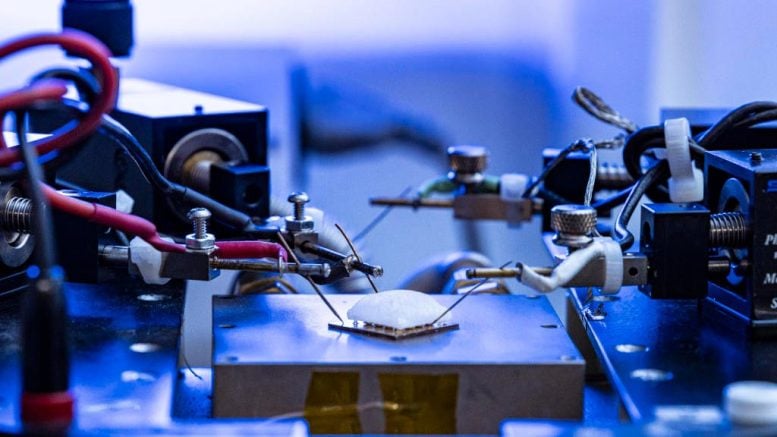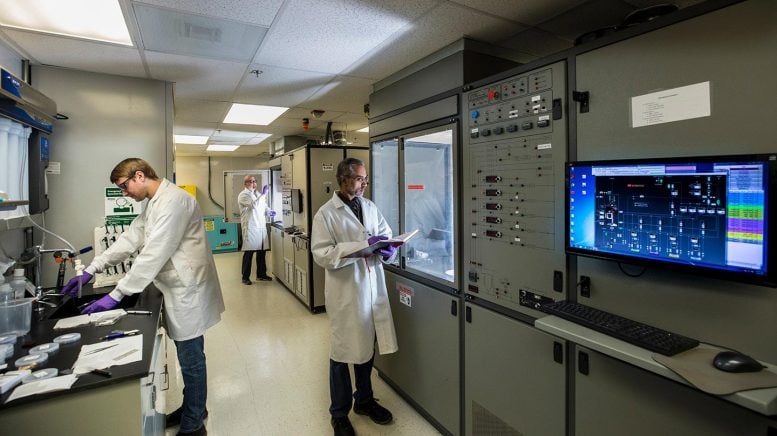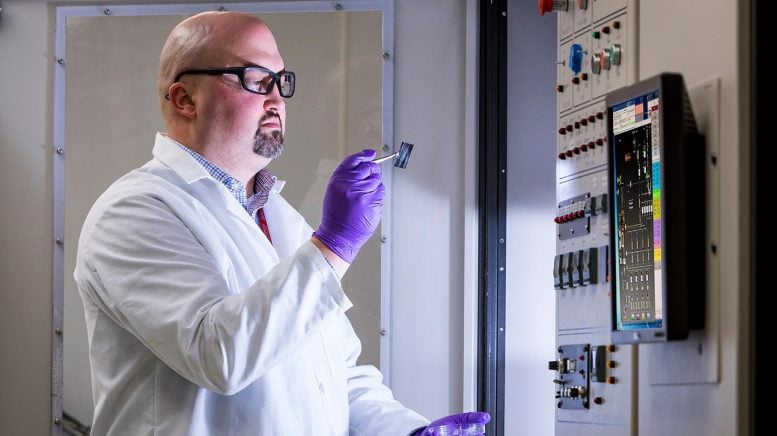
APL’s CHESS thin films nearly double refrigeration efficiency. The scalable materials could transform cooling and energy-harvesting technologies.
Scientists at the Johns Hopkins Applied Physics Laboratory (APL) in Laurel, Maryland, have created a new solid-state thermoelectric refrigeration system that is simple to manufacture and twice as efficient as devices built with standard bulk thermoelectric materials. As the global need for compact, reliable, and energy-efficient cooling technologies continues to rise, this development provides a promising alternative to conventional compressor-based refrigeration.
In a study published in Nature Communications, researchers from APL, working with refrigeration engineers at Samsung Research, demonstrated significant improvements in heat-pumping efficiency and cooling capacity. These gains were made possible through high-performance nano-engineered thermoelectric materials developed at APL, known as controlled hierarchically engineered superlattice structures (CHESS).
The CHESS platform represents the culmination of a decade of APL research on advanced nano-engineered thermoelectrics and their applications. Originally designed for national security purposes, the material has since been adapted for other uses, including noninvasive cooling therapies for prosthetics, and was recognized with an R&D 100 award in 2023.

“This real-world demonstration of refrigeration using new thermoelectric materials showcases the capabilities of nano-engineered CHESS thin films,” said Rama Venkatasubramanian, principal investigator of the joint project and chief technologist for thermoelectrics at APL. “It marks a significant leap in cooling technology and sets the stage for translating advances in thermoelectric materials into practical, large-scale, energy-efficient refrigeration applications.”
A New Benchmark for Solid-State Cooling
The demand for smaller, more efficient cooling technologies is being driven by population growth, urban expansion, and the growing dependence on advanced electronics and large-scale data systems. Although traditional cooling methods are effective, they tend to be bulky, consume significant amounts of energy, and rely on chemical refrigerants that can damage the environment.
Thermoelectric refrigeration offers a promising alternative. This approach transfers heat using electrons within specialized semiconductor materials, eliminating the need for moving parts or chemical coolants. As a result, these systems can be made compact, quiet, reliable, and environmentally sustainable. While bulk thermoelectric materials are already used in small products such as mini-refrigerators, their low efficiency, limited heat-transfer capacity, and poor compatibility with semiconductor chip manufacturing have restricted their adoption in larger, high-performance applications.

In the study, researchers compared refrigeration modules using traditional bulk thermoelectric materials with those using CHESS thin-film materials in standardized refrigeration tests, measuring and comparing the electrical power needed to achieve various cooling levels in the same commercial refrigerator test systems. Samsung Research’s Life Solution Team, led by executive vice president Joonhyun Lee, collaborated with APL to validate the results through detailed thermal modeling, quantifying heat loads and thermal resistance parameters to ensure accurate performance evaluation under real-world conditions.
The results were striking: Using CHESS materials, the APL team achieved nearly 100% improvement in efficiency over traditional thermoelectric materials at room temperature (around 80 degrees Fahrenheit, or 25 C). They then translated these material-level gains into a near 75% improvement in efficiency at the device level in thermoelectric modules built with CHESS materials and a 70% improvement in efficiency in a fully integrated refrigeration system, each representing a significant improvement over state-of-the-art bulk thermoelectric devices. These tests were completed under conditions that involved significant amounts of heat pumping to replicate practical operation.
Built to Scale
Beyond improving efficiency, the CHESS thin-film technology uses remarkably less material — just 0.003 cubic centimeters, or about the size of a grain of sand, per refrigeration unit. This reduction in material means APL’s thermoelectric materials could be mass-produced using semiconductor chip production tools, driving cost efficiency and enabling widespread market adoption.
“This thin-film technology has the potential to grow from powering small-scale refrigeration systems to supporting large building HVAC applications, similar to the way that lithium-ion batteries have been scaled to power devices as small as mobile phones and as large as electric vehicles,” Venkatasubramanian said.

Additionally, the CHESS materials were created using a well-established process commonly used to manufacture high-efficiency solar cells that power satellites and commercial LED lights.
“We used metal-organic chemical vapor deposition (MOCVD) to produce the CHESS materials, a method well known for its scalability, cost-effectiveness, and ability to support large-volume manufacturing,” said Jon Pierce, a senior research engineer who leads the MOCVD growth capability at APL. “MOCVD is already widely used commercially, making it ideal for scaling up CHESS thin-film thermoelectric materials production.”
Future applications and energy harvesting
These materials and devices continue to show promise for a broad range of energy harvesting and electronics applications, in addition to the recent advances in refrigeration. APL plans to continue to partner with organizations to refine the CHESS thermoelectric materials with a focus on boosting efficiency to approach that of conventional mechanical systems. Future efforts include demonstrating larger-scale refrigeration systems, including freezers, and integrating artificial intelligence-driven methods to optimize energy efficiency in compartmentalized or distributed cooling in refrigeration and HVAC equipment.
“Beyond refrigeration, CHESS materials are also able to convert temperature differences, like body heat, into usable power,” said Jeff Maranchi, Exploration Program Area manager in APL’s Research and Exploratory Development Mission Area. “In addition to advancing next-generation tactile systems, prosthetics and human-machine interfaces, this opens the door to scalable energy-harvesting technologies for applications ranging from computers to spacecraft — capabilities that weren’t feasible with older bulkier thermoelectric devices.”
“The success of this collaborative effort demonstrates that high-efficiency solid-state refrigeration is not only scientifically viable but manufacturable at scale,” said Susan Ehrlich, an APL technology commercialization manager. “We’re looking forward to continued research and technology transfer opportunities with companies as we work toward translating these innovations into practical, real-world applications.”
Reference: “Nano-engineered thin-film thermoelectric materials enable practical solid-state refrigeration” by Jake Ballard, Matthew Hubbard, Sung-Jin Jung, Vanessa Rojas, Richard Ung, Junwoo Suh, MinSoo Kim, Joonhyun Lee, Jonathan M. Pierce and Rama Venkatasubramanian, 21 May 2025, Nature Communications.
DOI: 10.1038/s41467-025-59698-y
Never miss a breakthrough: Join the SciTechDaily newsletter.
7 Comments
We used to gang these up to reach near liquid nitrogen temperatures to chill our detectors. We no longer need this for this application (newer detectors can operate at higher temperatures) but other detectors could probably benefit from this.
I wonder how much heat flow these can accommodate. That is the key for bulk refrigeration.
If I could have a refrigerator that was twice as energy efficient and completely silent AND would cost half of the ridiculous prices on working fluid units, yeah, I’d go for it. Who wouldn’t? Like all research lab advances, it’s unlikely the general public will see consumer level products using this technology any time soon. Years ago, there were many articles on using high power S band variable gain amplifiers in microwave ovens that would provide for continuous power (heating) control. Seen any at Costco? No. Same with the flexible solar cell/roofing sheets. Seen any at Home Depot? No. How’s that fusion energy that’s “just around the corner” coming along? Need a few $T more for research maybe? All to say: it’s very nice, but call me when you’ve got something for sale.
So can this technology be adapted to produce heat pumps the actually work efficiently.
What if a refrigerator lasted 20÷ years like they did in the 1950s? Efficiency means nothing if your fridge quits in 3 years.
No moving parts implies longevity possibilities.
My father sold Frigidaires in the early 50s. They sold them based on low power demand… except for International. For those they pointed out they stayed on longer than others. Our Frigidaire refrigerator lasted into the 80s without problems until the house was torched. I saw an International refrigerator in the teacher’s lounge in the 90s until the school was closed. Both impressive.
100% better than 3-5% efficiency of existing thermoelectric devices puts this thing in the 6-10% efficiency range. Already exceeded by PbTags material available right now through Mkcropower Global out of Texas, which has struggled to commercialize their products at 15% efficiency.
Thermoelectric aren’t typically used in refrigerators, just some cheap coolers where they are plugged into 12v when power is plentiful (when a care is driving). I’ve been messing with these things for years. They need to approach 20% efficiency to make a dent in any market. Alas, vapor compression still reigns supreme for the time being.
If you want to help with refrigerator development , try a UV system in the interior that cycles to rid the bacteria from food spoilage , add a Uv compartment on the outer face of the fridge to sanitize your Iphone good place to remember where you left it .